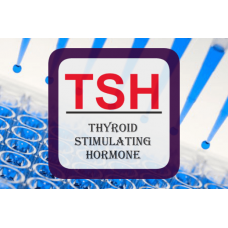Shopping Cart
0 item(s) - $0.00Thyroid Stimulating Hormone ELISA - Ultra-Sensitive TSH (U-TSH)
Availability: In Stock
Add to Compare
Enzyme Immunoassay for the Quantitative Determination of Thyroid Stimulating Hormone (TSH) in Human Serum
FOR RESEARCH USE ONLY. NOT FOR USE IN DIAGNOSTIC PROCEDURES
SUMMARY
The determination of serum or plasma levels of thyroid stimulating hormone (TSH or thyrotropin) is recognized as an important measurement in the assessment of thyroid function.1 Thyroid stimulating hormone is secreted by the anterior lobe of the pituitary gland, and induces the production and release of thyroxine (T4) and triiodothyronine (T3) from the thyroid gland.2 It is a glycoprotein with a molecular weight of approximately 28,000 daltons, consisting of two chemically different subunits, alpha and beta.
Although the concentration of TSH in the blood is extremely low, it is essential in the maintenance of normal thyroid function. The release of TSH is regulated by a TSH-releasing hormone (TRH) produced by the hypothalamus. The levels of TSH and TRH are inversely related to the level of thyroid hormone. When there is a high level of thyroid hormone in the blood, less TRH is released by the hypothalamus, so less TSH is secreted by the pituitary. The opposite action will occur when there are decreased levels of thyroid hormones in the blood. This process, known as a negative feedback mechanism, is responsible for maintaining the proper blood levels of these hormones.
Conventional TSH assays are generally accepted as an important tool in the diagnosis of primary and secondary hypothyroidism1, but offer limited clinical utility in the assessment of hyperthyroidism (overactive thyroid) due to a lack of sensitivity. The United Immunoassay U-TSH offers a sensitivity of 0.05 uIU/mL and hence allows discrimination between hyperthyroid and normal patient populations. The assay is intended to quantitatively measure TSH in human serum with 2nd generation sensitivity. The U-TSH ELISA can be used as an aid in the assessment of thyroid status, and diagnosis and treatment of thyroid disease.
PRINCIPLE OF THE TEST
The United Immunoassay Ultrasensitive-TSH ELISA Test is based on the principle of a solid phase enzyme-linked immunosorbent assay.6,7 The assay system utilizes a unique monoclonal antibody directed against a distinct antigenic determinant on the intact TSH molecule. Mouse monoclonal anti-TSH antibody is used fore solid phase (microtiter wells) immobilization, and goat anti-TSH antibody is used in the antibody-enzyme (horseradish peroxidase) conjugate solution. The test sample is allowed to react simultaneously with the antibodies, resulting in the TSH molecule being sandwiched between the solid phase and enzyme-linked antibodies. After a 2 hour incubation at room temperature with shaking, the solid phase is washed with distilled water to remove unbound labeled antibodies. A solution of tetramethylbenzidine (TMB) is added and incubated for 20 minutes, resulting in the development of a blue color. The color development is stopped with the addition of 1N HCl, and the resulting yellow color is measured spectrophotometrically at 450 nm. The concentration of TSH is directly proportional to the color intensity of the test sample.
EXAMPLE OF STANDARD CURVE
Results of a typical standard run with optical density readings at
450 nm shown in the Y axis against Thyroid Hormone concentrations shown in the X axis. This standard curve is for the purpose of illustration only, and should not be used to calculate unknowns. Each user should obtain his or her own data and standard curve.

| General | |
| ANALYTE GROUP | Thyroid Stimulating Hormone (TSH) |
| GROUPING | Hormones:Thyroid |
| PRODUCT NAME | ELISA |
| STORAGE | Store the kit at 2-8°C |
| COUNTRY OF ORIGIN | USA |
| DISCOUNTS | Bulk Packaging; High Volume |
| ELISA | |
| TESTS PER KIT | 96 (12 x 8) |
| CALIBRATION RANGE | 0 - 10 uIU/mL (Recommended) |
United Immunoassay, Inc. © 2025


































